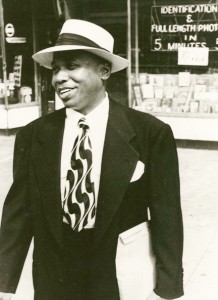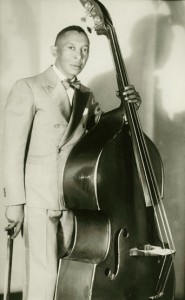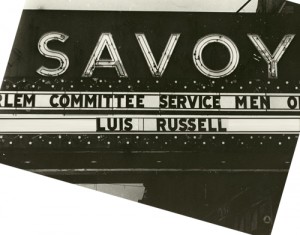Luis Russell got lucky—he won the lottery! And that money took the teenager from Panama to New Orleans. Then talent took over. We’ve got the story of this renowned pianist, arranger, songwriter and bandleader, who backed Louis Armstrong on his rise to stardom and helped pioneer the modern rhythm section in jazz.
On the radio now,The Luis Russell Story, as his daughter the magnificent vocalist Catherine Russell joins The Jim Cullum Jazz Band with Dick Hyman on piano.
In 1917 when the first jazz records sent shock waves through popular culture in the United States, 15-year-old Luis Russell was earning pocket money playing piano in the silent movie houses of Panama. Yankee soldiers would break into applause when he spiced up his repertoire with an American jazz tune like "Panama," performed on our show by Jim Cullum and the Band.
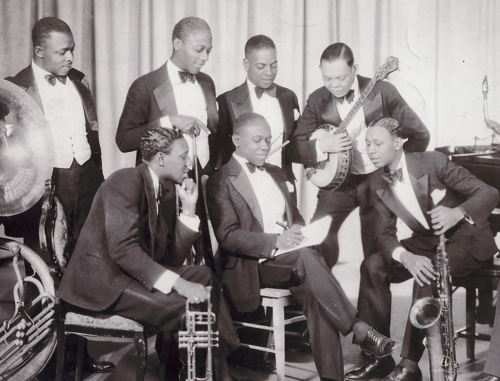
Luis Russell band, NYC 1928. L to R: William Moore-tuba, Luis Metcalf-tumpet, JC Higginbotham-trombone, Luis Russell-piano/arranger, Paul Barbarin-drums, Bill Johnson-banjo, Teddy Hill-tenor sax, Ven/Len Fields-alto sax. Photo courtesy of the Frank Driggs Collection.
Fate handed young Luis Russell the chance of a lifetime. On a lark he bought a lottery ticket and won $3,000—the equivalent of about $50,000 today. His family decided that he should move north to New Orleans with his mother and sister. Already an accomplished pianist, he fell into the Crescent City jazz scene easily with a gig at Tom Andersen’s cabaret in Storyville. Soon he was on his way to Chicago to work with the great King Oliver. By the mid-20s the jazz scene shifted to New York and Luis Russell made the move, landing on his feet and leading a band at a hot spot called The Nest.
A perpetually good-natured man and a snappy dresser who stood just a little over five feet tall, Luis Russell went on to become one of the most popular bandleaders in late 1920s' New York. Russell knew how to hold a band together, had a good ear for arranging and the vision for a highly individual band style. Jim Cullum says, "I always admired the Luis Russell Orchestra for its great soloists—even before Armstrong joined them—and especially for its own unique core sound and style."
By 1929 Russell's loose, swinging ensemble boasted such strong soloists as trombone great J.C. Higginbotham and trumpeter Henry 'Red' Allen. Russell's rhythm section featured the New Orleans men Pops Foster on bass, Paul Barbarin on drums and Danny Barker on guitar.
Bassist Pops Foster recalled:
"We played the Savoy Ballroom, then we went to the Roseland and took Fletcher Henderson's job away from him. The rhythm was really rompin’, man, I mean, really bouncing. And, the trumpet players were screaming soft—so you could hear the people’s feet scraping the floor. We worked seven days a week and we loved it. It was like back home in New Orleans. Luis Russell’s band was rompin’ so good in 1929, we had everything around New York sewed up!"
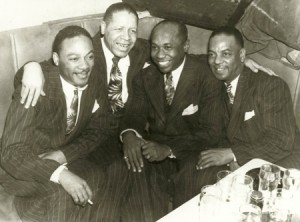
JC Higginbotham, Henry Red Allen, Luis Russell, Paul Barbarin, 1942 Chicago. Photo courtesy of the Frank Driggs Collection.
Trumpeter Red Allen remembered:
"That first week was scary. Then, I learned it was the kind of band that hung out like family. It had a brotherly love thing going. It was the most swinging band in New York. It put audiences in an uproar. Russell did most of the arrangements and when you took a solo—the whole band just caught fire."
After a long tour through the South with Louis Armstrong, the Luis Russell Orchestra would be hand-picked to back Armstrong on his rise to stardom. That tour was the beginning of a lifelong friendship between Russell and Armstrong that never wavered.
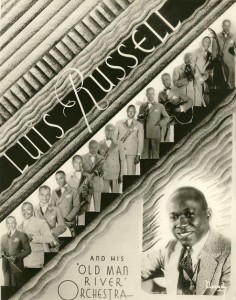
Luis Russell Orch, 1934 L to R: Sonny Woods, Rex Stewart, Nat Story, Paul Barbarin, Charlie Homes, Henry 'Moon' Jones, Leonard 'Ham' Davis, Bingie Madison, Greeley Walton, Lee Blair, Jimmy Archey, Gus Aiken, Pops Foster. Photo courtesy of the Frank Driggs Collection.
Armstrong would remember the Luis Russell Orchestra like this:
"Lew Russell’s band is, without a doubt, one of the finest aggregations of swing players, all in one band, that you will ever find. When I am swinging my trumpet out in front of them—I always know that however far I swing away from the music we’re playing—wherever the trumpet carries them—they will be right there, following close—hot and sure of their rhythm—and never losing their way for one second. It’s just as though they could see right through my back and know what’s coming next—almost as soon as I do—I was very proud ‘n’ happy to have played in that band every night."
1929 was a big year for the Luis Russell Orchestra. They moved into the Saratoga Club, a sprawling cabaret in Harlem that became their headquarters. A highlight of the year was a series of hit records, including one of Russell’s original compositions featuring the band’s star bassist, Pops Foster. They called it "Jersey Lightning." In our version Dick Hyman tackles this difficult tune as an unaccompanied piano solo, we believe the first time this has ever been done.
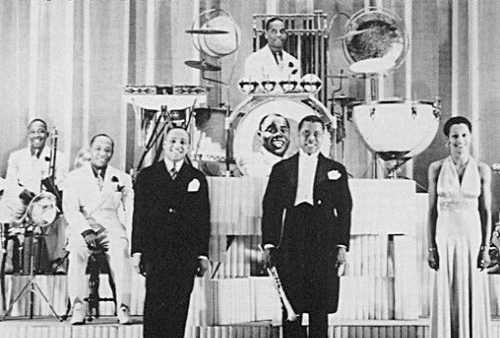
Louis Armstrong with The Luis Russell Orchestra. Photo courtesy Louis: The Louis Armstrong Story by Max Jones and John Chilton.
Louis Armstrong was a rising star, and this ensemble backed him on radio dates, on the road and for recording dates. From 1935 to '43, the Luis Russell Orchestra worked with Armstrong full-time and eventually morphed into the Louis Armstrong Orchestra.
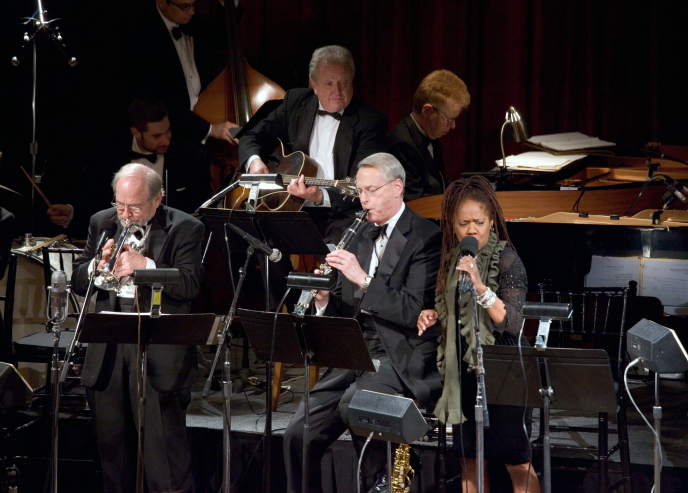
Ric Ramirez-bass, Mike Waskiewicz-drums, Jim Cullum Jr.-cornet, Howard Elkins-guitar, Jim Turner-piano, Ron Hockett-clarinet and Catherine Russell-vocals, Pearl Stable 2010. Photo by Jamie Karutz.
Catherine Russell remembers her father's legacy with us, performing songs he wrote like "Back O Town Blues," "Slow as Molasses" and "Sad Lover Blues" with The Jim Cullum Jazz Band and Dick Hyman on piano. A highlight of the radio tribute is her performance of a piece her father recorded with Louis Armstrong in 1938, "So Little Time, So Much to Do."
Photo credit for Home Page: Special guest Catherine Russell at the piano with her father, Luis Russell. Photo courtesy of the artist.
Text based on Riverwalk Jazz script by Margaret Moos Pick©2011


